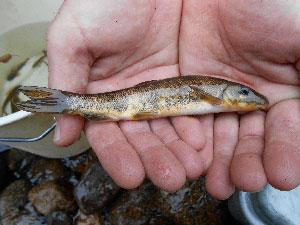Longnose Sucker
Catostomus catostomus
 Distribution: Longnose suckers are widespread throughout northern North America. They inhabit all of Alaska and Canada with a more patchy distribution in the northern United States. Longnose Suckers reach their southern limit in Washington, Idaho, Colorado, Minnesota, Nebraska, Ohio, West Virginia, and Maryland. In New Hampshire, they are primarily a northern species found in the Androscoggin and upper Connecticut River drainages, although they have been documented in the Connecticut River watershed as far south as the Cold River in Walpole. There may also be some isolated populations of longnose suckers in the Pemigewasset River and upper Saco River watersheds.
Distribution: Longnose suckers are widespread throughout northern North America. They inhabit all of Alaska and Canada with a more patchy distribution in the northern United States. Longnose Suckers reach their southern limit in Washington, Idaho, Colorado, Minnesota, Nebraska, Ohio, West Virginia, and Maryland. In New Hampshire, they are primarily a northern species found in the Androscoggin and upper Connecticut River drainages, although they have been documented in the Connecticut River watershed as far south as the Cold River in Walpole. There may also be some isolated populations of longnose suckers in the Pemigewasset River and upper Saco River watersheds.
Description: Longnose suckers are similar in appearance to white suckers except for a protruding snout that extends past the upper lip. The lower lip on the longnose sucker is larger than that of the white sucker and its scales are smaller. Male longnose suckers become reddish in color with horny tubercles on their fins during the spawning season.
Species commonly confused with: White sucker
Habitat: Longnose suckers prefer cool, moderate gradient streams and rivers with gravel or rubble substrate. They may also be found in the deeper water of northern lakes.

Life History: Longnose suckers are a relatively long-lived fish species, with life spans sometimes exceeding 20 years. They are slow to reach maturity, usually spawning after about 5 years. Longnose suckers migrate to gravel spawning grounds in small streams in early spring. They are vulnerable to predation as they congregate during spawning, which takes place during the day. Longnose suckers do not build nests. Their eggs are adhesive and stick to the gravel substrate. Longnose suckers are bottom feeders, preying primarily on benthic invertebrates. Populations in the Connecticut River and upper Merrimack River watersheds belong to a subspecies known as dwarf longnose suckers which rarely exceed 10 inches in length. The subspecies, known as the eastern longnose sucker, in the Androscoggin drainage may grow up to 20 inches in length.
Origin: Native
Conservation/Management: Longnose suckers are listed as endangered in Pennsylvania and Ohio and as species of Concern in New York and Massachusetts. There are signs that their range is contracting and shifting northward. New Hampshire populations should be monitored for signs of range shifts due to increases in water temperature caused by climate change or for local impacts to populations caused by expanding development in northern New Hampshire.



